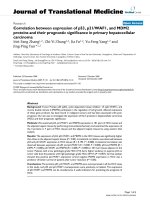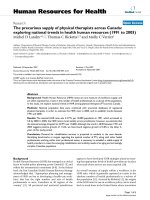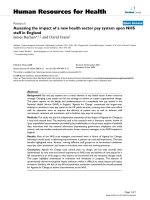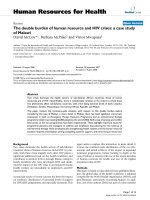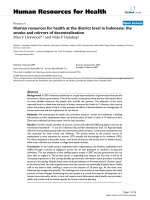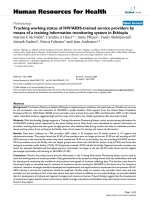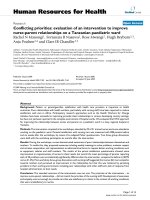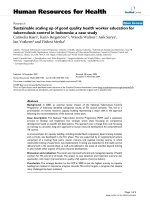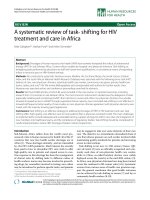Báo cáo sinh học: "Curcumin reduces expression of Bcl-2, leading to apoptosis in daunorubicin-insensitive CD34+ acute myeloid leukemia cell lines and primary sorted CD34+ acute myeloid leukemia cells" pptx
Bạn đang xem bản rút gọn của tài liệu. Xem và tải ngay bản đầy đủ của tài liệu tại đây (1.9 MB, 15 trang )
RESEARCH Open Access
Curcumin reduces expression of Bcl-2, leading to
apoptosis in daunorubicin-insensitive CD34
+
acute myeloid leukemia cell lines and primary
sorted CD34
+
acute myeloid leukemia cells
Jia Rao
1,2
, Duo-Rong Xu
2,3*
, Fei-Meng Zheng
4
, Zi-Jie Long
1,2
, Sheng-Shan Huang
5
, Xing Wu
1,2
, Wei-Hua Zhou
1,2
,
Ren-Wei Huang
1,2*
and Quentin Liu
1,2,4*
Abstract
Background: Acute myeloid leukemia (AML) is an immunophenotypically heterogenous malignant disease, in which
CD34 positivity is associated with poor prognosis. CD34
+
AML cells are 10-15-fo ld more resistant to daunorubicin
(DNR) than CD34
-
AML cells. Curcumin is a major component of turmeric that has shown cytotoxic activity in
multiple cancers; however, its anti-cancer activity has not been well studied in DNR-insensitive CD34
+
AML cells. The
aim of this study was to therefore to explore curcumin-induced cytotoxicity in DNR-insensitive CD34
+
AML cell lines
(KG1a, Kasumi-1), DNR-sensitive U937 AML cells, and primary CD34
+
AML bone-marrow-derived cells.
Methods: Primary human CD34
+
cells were isolated from peripheral blood mononuclear cells or bone marrow
mononuclear cells using a CD34 MicroBead kit. The growth inhibitory effects of curcumin were evaluated by MTT
and colony-formation assays. Cell cycle distribution was examined by propidium iodide (PI) assay. Apoptosis was
analyzed by Wright-Giemsa, Hoechst 33342 and Annexin-V/PI staining assays. The change in mitochondrial
membrane potential (MMP) was examine d by JC-1 staining and flow cytometry. Expression of apoptosis-related
proteins was determined by reverse transcription-polymerase chain reaction and Western blotting. Short interfering
RNA (siRNA) against Bcl-2 was used in CD34
+
KG1a and Kasumi-1 cells incubated with/without DNR.
Results: Curcumin inhibited proliferation and induced apoptosis and G1/S arrest in both DNR-insensitive KG1a,
Kasumi-1 and DNR-sensitive U937 cells. Curcumin-induced apoptosis was associated with reduced expression of
both Bcl-2 mRNA and protein, subsequent loss of MMP, and activation of caspase-3 followed by PARP degradation.
Curcumin synergistically enhanced the cytotoxic effect of DNR in DNR-insensitive KG1a and Kasumi-1 cells,
consistent with decreased Bcl-2 expression. Accordingly, siRNA against Bcl-2 increased the susceptibility of KG1a
and Kasumi-1 cells to DNR-induced apoptosis. More importantly, curcumin suppressed Bcl-2 expression, selectively
inhibited proliferation and synergistically enhanced the cytotoxicity of DNR in primary CD34
+
AML cells, while
showing limited lethality in normal CD34
+
hematopoietic progenitors.
Conclusion: Curcumin down-regulates Bcl-2 and induces apoptosis in DNR-insensitive CD34
+
AML cell lines and
primary CD34
+
AML cells.
* Correspondence: ; ;
edu.cn
1
Department of Hematology, Third Affiliated Hospital, Sun Yat-sen University,
600 Tianhe Road, Guangzhou 510630, P.R. China
2
Sun Yat-sen Institute of Hematology, 600 Tianhe Road, Guangzhou 510630,
P.R. China
Full list of author information is available at the end of the article
Rao et al. Journal of Translational Medicine 2011, 9:71
/>© 2011 Rao et al; licensee BioMed Central Ltd. This is an Open Access article distributed under the terms of the Creative Commons
Attribution License ( http://creativecommons .org/licenses/by/2.0), which permits unrestricted use, distribution, and reproduction in
any medium, provided the original work is properly cited.
Background
Acute myeloid leukemia (AML ) is an immunophenotypi-
cally heterogenous malignant disease, in which CD34 posi-
tivity has been significantly correlated with a lower
complete response (CR) rate, drug resistance and po or
outcome [1-3]. Treatment of AML has generally consisted
of a combination of cytarabine and an anthracycline such
as daunorubicin (DNR), or the anthracenedione mitoxan-
trone [4]. Although conventional chemotherapy regimens
induce CR in 65-80% of newly diagnosed AML patients,
most patients who achieve a CR relapse within 2 y ears
from diagnosis [5]. At relapse, blast cells usu ally display a
more immature phenotype, with one of the most common
antigenic changes being a gain in expression of the stem
cell antigen CD34 [6,7]. This is reflected in the resistance
of these immature phenotype CD34
+
AML progenitors to
current chemotherapies.
CD34
+
AML cells are 10-15-fold more resistant to
DNR than CD34
-
AML cells [8]. CD34
+
KG1a and TF-1
AML cell lines are 30-40 fold more resistant to mitox-
antrone than more mature HL-60 and U937 cells, and
this resistance appears to be associated with the lack of
apoptosis [9]. Increasing evidence indicates that CD34
+
AML cells are less sensitive to spontaneous apoptosis
and have higher levels of Bcl-2 and Bcl-xl gene and pro-
tein expression than the CD34
-
subpopulation [6,10-12].
CD34 positivity has been reported to be another indica -
tor of poor prognosis in AML [3,12], and use of more
effective drugs to eliminate this early immature CD34
+
AML cell subpopulation might therefore improve the
outcome of AML.
DNR is one of the most commonly used anti-leukemia
agents. Bcl-2 overexpression can block DNR-induced
apoptosis in more mature U937 AML cells [13]. The
anti-apoptotic proteins Bcl-2 and Bcl-xl also contribute
to the survival and chemoresistance of quiescent leuke-
mia CD34
+
cells [14]. These findings suggest that Bcl-2
plays a critical role in CD34
+
AML cell survival and that
agents aimed at down-regulati ng Bcl-2 protein might be
effectiveforthetreatmentofDNR-insensitiveCD34
+
AML.
Curcumin, a major yellow pigment in turmeric, has
been proven to be a powerful therapeutic drug [15,16].
Curcumin induces apoptosis i n a variety of tumor cells,
including more mature H L-60 and U937 cell lines,
through activation of caspase-3, cytochrome c release,
and down-regulation of Bcl-2 [17-20]. Curcumin inhibits
proliferation in a variety of cancer cells through target-
ing multiple cellular signaling pathways [21], including
the mitogen-activated protein kinase [22], nuclear factor
kappaB [23], phosphoinosi tide-3 kinase/Akt/mammalian
target of rapamycin [24,25], Wnt [26], and Notch-
mediated signaling pathways [27]. Curcumin has also
been found to be a powerful chemosensitizing agent in
tumor cells. It demonstrated no major toxicities in
phase I and II clinical studies at doses of up to 8 g/day
[28,29]. However, the cytotoxic effects of curcumin in
DNR-insensitive CD34
+
immature AML cells remain
unclear.
In this study, we examined the cytotoxic efficiency and
molecular mechanisms underlying the anticancer activity
of curcumin in both DNR-insensitive CD34
+
immature
AML cell lines and in primary CD34
+
AML cells.
Methods
Materials
Curcumin (Sigma, St. Louis, MO) was dissolved in
dimethyl sulfoxide (DMSO) to pr epare a 100-mM stock
solution that was stored at -20°C. DNR was purchased
from Pharmacia & Upjohn SpA (Milan, Italy). Annexin-V
assay kit was purchased from Molecular Probes (Eugene,
OR, USA). Anti-cleaved PARP, cleaved caspase-3, and
Bcl-2 antibodies were purchased from Cell Signaling
Technologies (Beverly, MA, USA). Anti-GAPDH anti-
body and goat anti-rabbit/mouse-horseradish peroxidas e
(HRP)-conjugated secondaryantibodywerepurchased
from Protein Tech Group (Chicago, IL, USA). JC-1 kit
was purchased from Beyotime (China). CD34-PE and
IgG1-PE monoclonal antibodies were purchased from BD
Biosciences (San Jose, CA, USA). CD34 MicroBead kit
was purchased from Miltenyi biotec (Auburn, CA, USA).
Cell lines, primary samples, and cell culture
KG1a and Kasumi-1 cell lines were obtained from
Deutsche Sammlung von Mikroorganismen un d Zellkul-
turen GmbH (DSMZ) (Braunschweig, Germany) and
grown i n RPMI 1640 medium (Gibco; Invitrogen, Carls-
bad, CA, USA) supplemented with 20% (v/v) fetal bovine
serum (FBS; Hyclone, Logan, UT). According to immu-
nological studies by DSMZ and oth ers [ 30,31], KG1a and
Kasumi-1 cells are characterized by high expressi on of
CD34 surface antigen. U937 cells were obtained from the
American Type Culture Collection (ATCC) and grown in
RPMI 1640 medium supplemented with 10% FBS. Cells
were cultured at 37°C in a humidifi ed atmosphere con-
taining 5% CO
2
. Control cultures received an equivalent
amount of DMSO only. Bone marrow mononuclear cells
(BMMCs) or mobilized peripheral blood mononuclear
cells (PBMCs) were obtained from 9 newly diagnosed
AML patients and 8 healthy donors. All donors provided
written informed consent, and the study had the approval
of the Institute Research Ethics Committee at Sun Yan-
sen University, in a ccordance with the Declaration of
Helsinki. Patient characteristics are shown in Table 1.
PBMCs and BMMCs were enriched by Ficoll-Hypaque
density gradient centrifugation and isolated using a CD34
Rao et al. Journal of Translational Medicine 2011, 9:71
/>Page 2 of 15
MicroBead kit. BMMCs and PBMCs were stained with
PE-conjugated anti-CD34 to deter mine the purity of
CD34
+
cells.
MTT assay
Viability was assessed by MTT assay. Briefly, 1.0×10
4
cells were incubated in triplicate in a 96-well plate in the
presence or absence of the indicated test samples in a
final volume of 0.2 ml for various lengths of time at 37°C.
Thereafter, 20 μl MTT solution (5 mg /ml in PBS) wa s
then added to each well. After 4-h incubation at 37°C,
150 μl DMSO was added. Finally the pla tes were shaken
and the optical density at 490 nm was measured using a
multiwell plate reader (Microplate Reader; Bio-Rad,
Hercules, CA). Percent cell viability was calculated as cell
viability of the experimental samples/cell viability of the
control samples × 100. At least three independent experi-
ments were performed.
Colony-forming assay
Treated and untreated cells were cultured in RPMI 1640
medium supplemented with 0.9% methylcellulose and
20% FBS at 37°C in 5% CO
2
. The colonies (containing
50 or more cells) were counted by light microscopy
aft er 14 days. All semi-solid cultures were performed in
triplicate. Three independent experiments were
performed.
Wright-Giemsa staining
Morphological signs of apoptosis were detected by
Wright-Giemsa staining. Cells were treated with 0-80 μM
curcumin for 24 h. Smears of control and tre ated cells
were stained with Wright-Giemsa solution for 25 min,
rinsed with distilled water and air dried. Cell morphology
was studied by light microscopy.
Hoechst 33342 staining
Nuclear fragmentation was examined by Hoechst 33342
(Sigma). Cells treated with 0-80 μMcurcuminfor24h
were washed and stained with Hoechst 33342 (10 μg/ml)
for 15 min at 37°C. Slides were viewed using a fluores-
cence microscope.
Measurement of apoptosis by Annexin V analysis
An Annexin V-binding assay was used according to the
manufacturer’ s instructions. Briefly, approximately
5×10
5
/ml cells in 6-well plates were treated with various
concentrations of the indicated test samples. The cells
were harvested and used for Annexin V-Alexa Fluor-
488/PI staining. The stained cells were analyzed by flow
cytometry to determine the p ercentages of AnnexinV
+
/PI
-
(early apoptosis) and AnnexinV
+
/PI
+
(late apopto-
sis) cells.
Cell cycle analysis
Cell cycle was analyzed by flow cytometry. Approxi-
mately 5 × 10
5
/ml cells in 6-well plates were treated
with various concentrations of curcumin for 24 h. Cell
cycle analysis was performed using the CycleTEST™
PLUS DNA kit (BD Biosciences).
Detection of mitochondrial membrane potential (MMP,
Δψm) using JC-1
MMP was estimated by flow cytometry after staining
with JC-1 fluorescent dye. W hen the cell is in a normal
state, MMP is high and JC-1 predominantly appears as
red fluorescence. When the cell is in an apoptotic or
necrotic state, the MMP is reduced and JC-1 appears as a
monomer indicated by green fluorescence. A change in
the florescence from red to green indicates a decrease in
the MMP. Approximately 5×10
5
/ml cells in 6-well plates
were treated with various con centrations of curcumin fo r
24 h. The cells were then washed with PBS and incubated
with JC-1 working solution for 20 min at 37°C in the
dark. Cells were washed with PBS and resuspended in
500 μl PBS. The stained cells were analyzed by flow cyto-
metry to determine the cha nge in the florescence from
red to green.
Table 1 Characteristic of patients
Patient# Age/Sex FAB WBC(*109/L) %CD34 in BMC* Source Cytogenetics
P1 35 Y/M M2 9.09 67.3 BM 46 XY
P2 60 Y/M M2b 15.80 72.1 BM 46 XY, t(8;21),AML1/ETO #
P3 46 Y/M M5 12.00 56.0 BM 46 XY
P4 17 Y/M M5b 3.39 89.1 BM 46 XY
P5 28 Y/M M2b 11.37 76.3 BM 46 XY, t(8;21),AML1/ETO #
P6 20 Y/M M1 10.03 70.1 BM 46 XY
P7 78 Y/M M4 101.08 52.1 PB 46 XY inv (16)(p13q22)
P8 72 Y/F M2a 1.95 31.5 PB 46 XX
P9 54 Y/M M1 103.79 62.8 BM 46 XY
P patient, Y year, M male, FAB French-American-British, WBC white blood cells, BMC bone marrow cells, BM bone marrow, PM peripheral blood.*Percentage of
CD34
+
cells in bone marrow cells of AML patients before sorting.
#
The t (8; 21) (q22; q22) chromosomal translocation gives rise to the AML1/ETO fusion
oncoprotein.
Rao et al. Journal of Translational Medicine 2011, 9:71
/>Page 3 of 15
RNA isolation and semiquantitative reverse transcription-
polymerase chain reaction (RT-PCR)
Total RNA was extracted using Trizol isolation reagent
(Invitrogen, USA). Reverse transcription was performed
using a reverse transcriptase first strand cDNA synthesis
kit (Takara, Japan). The sequences of the sense and anti-
sense primers were: 5’ -CTGGTGGACAACATCGC-3’
(sense) and 5’ -GGAGAAATCAAACAGAGGC-3’ (anti-
sense) for Bcl-2, 5’-TGACTTTTCCTGTGAACTCT-3’
(sense) and 5’-GCCTTTCATTCGTATCAAGA-3’ (anti-
sense) for c-IAP-1, 5’-GCAGGGTTTCT TTATACTG-3’
(sense) and 5’ -TGTCCCTTCTGTTCTAACAG- 3’ (anti-
sense) for XIAP [32], 5’-GTGGACATCCGCAAAGAC-
3’ (sense) and 5’ -GAAAGGGTGTAA CGCAACT-3’
(anti-sense) for b-actin. The PCR conditions were as fol-
lows: for c-IAP-1 and XIAP, 94°C for 1 min, 62°C for
1 min, and 72°C for 1 min; for Bcl-2, 94°C for 30 s,
62°C for 30 s, 72°C for 10 s; and for b-actin: 94°C for
30 s, 55°C for 30 s, 72°C f or 1 min. Thirty cycles of
amplification were used. PCR (10 μl) products were ana-
lyzed by electrophoresis on 2% (w/v) agarose gel.
Western blot analysis
Total cellula r proteins were isolated with l ysis buffer
(20 mM Tris, pH 7.5; 150 mM NaCl; 0.25% NP40;
2.5mMsodiumpyprophosphate;1mMEGTA,1mM
EDTA; 1 mM b-glycerophosphate; 1 mM Na
3
VO
4
;1mM
PMSF; 1 μg/ml leupeptin). Equal amounts of protein were
subjected to 10% or 15% sodium dodecyl sulfate-polyacry-
lamide gel electrophoresis and transferred to nitrocellulose
membranes. The membranes were treated with primary
antibodies overnight at 4°C and incubated with a HRP-
conjugated anti-mouse or anti-rab bit secondary antibody
at room temperature for 1 h. The protein bands wer e
visualized using an enhanced chemiluminescence reagent
(Pierce Biotechnology, USA), according to the manufac-
turer’sinstructions.
Short interfering RNA (siRNA) transfection
KG1a and Kasumi-1 cells wer e seeded ont o 6-well plates
for 24 h before transfection. Control scrambled siRNA
was synthesized and purchased from GenePharma (Shang-
hai Co. Ltd., China). SiRNA Bcl-2 (50 nM): 5’ -GGGA-
GAUAGUGAUGAAG UAUU-3’ [33] or control scramble
sequences were transfected using Lipofectamine 2000
reagent (Invitrogen), according to the manufacturer’spro-
tocol. Briefly, for each well, 5 μl Lipofectamine 2000 was
diluted in 250 μl Op ti-MEM me dium (I nvitrog en). Th e
mixture was gently added to a solution containing siRNA
in 250 μl Opti-MEMI medium and incubated for 20 min.
The mixture was then added to the plates. After transfec-
tion with siRNA for 24 h, cells were harvested for further
assay.
Statistical analysis
Data were presented as mean ± SD. One-way ANOVA fol-
lowed by Bonferroni multiple comparison was performed
to assess the differences between two groups under multi-
ple conditions. If the data failed the normality t est, the
Kruskal-Wallis one-way ANOVA on ranks was used. A
value of p < 0.05 was considered statistically significant.
Both Calcusyn software (Biosoft, Ferguson, MO, USA)
[34,35] and Jin’s formula [36] were used to evaluate the
synergistic effects of drug combinations. Jin’s formula is
givenas:Q=Ea+b/(Ea+Eb-Ea×Eb).Ea+brepresents
the cell proliferation inhibition rate of the combined
drugs, while Ea and Eb represent the rates for each drug
respectively. A value of Q = 0.85-1.15 indicates a simple
additive effect, while Q > 1.15 indicates synergism. Combi-
nation index (CI) plots were generated using CalcuSyn
software. A value of CI < 1 indicates synergism.
Results
CD34
+
KG1a and Kasumi-1cells were insensitive to DNR
KG1a, Kasumi-1 and U937 AML cells were stained with
PE-conjugated CD34 antibody and subjected to flow
cytometry to determine the purity of CD34
+
cells. The
percentages of CD34
+
cells were 99.43 ± 0.60% in KG1a
cells, 96.67 ± 0.11% in Kasumi-1 cells, but CD34
+
was
absent in U937 cells (Figure 1A). After tr eatment of
these three cell lines with different concentrations of
DNR for 48 h, MTT and apoptosis analyses showed that
DNR inhibited proliferation and induced apoptosis in
more mature U937 cells, but not in immature CD34
+
KG1a or Kasumi-1 cell lines (Figure 1B, C). This was in
accord with previous studies indicating that CD34
+
AML cells were insensitive to DNR. The concentration
of DNR used in this study was clinically achievable in
patients [37,38].
Curcumin suppressed cell growth and induced G1/S cell
cycle arrest in both DNR-insensitive and -sensitive AML
cell lines
KG1a, Kasumi-1 and U937 cell lines were exposed to
curcumin (0-100 μM) for 24, 48, 72 and 96 h. The cyto-
toxic effects of curcumin were d etermined by MTT
assay. Curcumin had a significant cytotoxic e ffect in all
tested cell lines in both dose- and time-dependent man-
ners (Figure 2B, C, D). The IC
50
values at 24, 48, 72,
and 96 h were 230.5, 86.9, 60.0, and 35.7 μMforKG1a,
68.5, 46.6, 28.8, and 23.5 μM for Kasumi-1, and 58.3,
26.0, 10.6, and 4.4 μM for U937 cells, respectively. The
antiproliferative effects of curcumin in these cell lines
were further determined using clonogenic assays. Curcu-
min inhibited clonogenic growth in a dose-dependent
manner, and completely inhib ited colony formation at a
dose as low as 20 μM (Figure S1A, B, Additional file 1).
Rao et al. Journal of Translational Medicine 2011, 9:71
/>Page 4 of 15
Cell cycle distributions in KG1a, Kasumi-1, and U937
cells were examined after treatment with curcumin for
24 h. As shown in Figure 2E, treatment of KG1a cells
with 80 μM curcumin resulted in a significant increase
in the percentage of cells in the G1 phase, from 46-62%,
and a decrease in the percentage of cells in the S phase,
from 39-23%. Similar results were found for Kasumi-1
and U937 cells. These results d emonstrated that curcu-
min induced G1/S arrest in both DNR-insensitive and
-sensitive AML cell lines.
M1
A
B
M1
M1
KG1a
U937
Kasumi-1
99.72 0.18
.*D
NDVXPL
X
Cell viability(%;MTT
assay)
***
***
***
Kasumi-1
Apoptosis(%)
.*D
NDVXPL
8
***
***
***
96.71
Daunorubicin(ȝg/ml)
Daunorubicin(ȝg/ml)
KG1a
U937
C
Annexin
č
PI
0 0.4 0.8 1.6
Daunorubicin(ȝg/ml)
1.65
8.13
0.02
90.19
1.35
10.15
0.00
88.50
4.84
0.89
94.27
0.00 0.37
2.69 26.94
0.00
1.32
4.65
0.01
94.02
0.69
3.64
0.00
95.67
0.42
3.51
0.00
96.07
0.56
3.69
0.05
95.70
14.16
26.56
12.68
46.60
12.39
16.13
48.40
23.08
8.78
19.60
1.62
69.99
0.64
2.75
0.01
96.60
Figure 1 CD34
+
KG1a and Kasumi-1cells were insensitive to DNR.(A) KG1a, Kasumi-1 and U937 cells were stained with PE-conjugated CD34
antibody and subjected to flow cytometry to determine the purity of CD34
+
cells. (B, C) These three cell lines were treated with different
concentrations of DNR for 48 h. MTT assay (B) was performed as described in “Methods” and apoptosis (C) was assessed by Annexin V/PI assays.
Cells in the lower right quadrant represent early apoptosis and those in the upper right quadrant represent late apoptosis. The graph displays
the means ± SD of three independent experiments. * p < 0.05, ** p < 0.01, *** p < 0.001 (compared with control).
Rao et al. Journal of Translational Medicine 2011, 9:71
/>Page 5 of 15
K
K
K
K
*0
6
**
Curcumin(ȝM)
K
K
K
K
C
Cell viability(%;MTT
assay)
Cell viability(%;MTT
assay)
KG1a
Kasumi-1
A
Curcumin
Curcumin(ȝM)
E
K
G
1
a
K
asu
mi-1
U9
3
7
Curcumin(ȝM)
D
K
K
K
K
B
Cell viability(%;MTT
assay)
Curcumin(ȝM)
U937
Figure 2 Curcumin suppressed cell growth and induced G1/S arrest.(A) Structure of curcumin. (B, C, D) KG1a, Kasumi-1 and U937 cell lines
were treated with different concentrations of curcumin for 24, 48, 72, and 96 h. MTT assay was performed. (E) These three cell lines were treated
with different concentrations of curcumin for 24 h and analyzed for DNA content by flow cytometry, as described in “Methods.” The bar
represents means ± SD of three independent experiments.
Rao et al. Journal of Translational Medicine 2011, 9:71
/>Page 6 of 15
Curcumin induced apoptosis through activation of
caspase-3 followed by PARP degradation in both DNR-
insensitive and -sensitive AML cell lines
To determine if growth inhibition induced by curcumin
was a result of apoptosis, the pro-apoptotic effect was
examined using Wright-Giemsa, Hoechst 3 3342 and
Annexin-V/PI staining. Both Wright-Giemsa and
Hoechst 33342 staining showed that curcumin induced
morphological changes such as cell shrinkage and nuclear
condensation, which are typical characteristics of apopto-
sis (Figure 3A; Figure S2A, Additional file 2). These mor-
phological changes were confirmed by flow cytometry.
Treatment with curcumin at 40 μMfor24hresultedin
apoptosis rates of 23.5 ± 8.8%, 36.1 ± 5.3%, and 40.1 ±
17.8% in KG1a, Kasumi-1 and U937 cells, respectively
(Figure 3B). Western blotting analysis further showed
that curcumin induced caspase-3 activation and PARP
cleavage, two hallmarks of apoptosis (F igure 3C). Both
Annexin-V/PI and Western blotting showed that curcu-
min induced apoptosis in a dose-dependent manner.
U937cells were the most sensitive to curcumin-induced
apoptosis, followed by Kasumi-1, then KG1a cells.
Curcumin decreased Bcl-2 mRNA and protein levels and
reduced MMP in both DNR-insensitive and -sensitive AML
cell lines
The mechanisms underlying curcumin-induced apo pto-
sis were investigated. The IAP and Bcl-2 family play an
important role in the regulation of cell apoptosis, and
the effects of curcumin on mRNA levels of c-IAP-1,
XIAP and Bcl-2 were therefore assessed by RT-PCR. As
shown in Figure 4A, Bcl-2 mRNA levels were signifi-
cantly down-regulated in both DNR-insensitive AML
cell lines (KG1a and Kasumi-1) and in DNR-sensitive
U937 cells, while the leve ls of c-IAP-1 and XIAP were
unchanged. Western blotting also demonstrated that
curcumin significantly down-regulated Bcl-2 protein
levels in a dose-dependent manner (Figure 4B). These
results suggest that down-regulation of Bcl-2 could con-
tribute to curcumin-induced apoptosis.
Disruption of the function of Bcl-2 protein leads to per-
meabilization of the mitochondrial m embrane [39]. We
therefore investigated the effects of curcumin on MMP
using JC-1 fluorescent dye and flow cytometry. Exposure
of the th ree cell lines to increasing doses of curcumin for
24 h led to a significant reduction in the MMP (Figure
4C). These results suggest that curcumin-induced apopto-
sis is mitochondria-dependent.
Curcumin synergistically enhanced the cytotoxic effect of
DNR in DNR-insensitive KG1a and Kasumi-1 cells,
associated with down-regulation of Bcl-2
To determine if curcumin could enhance the cytotoxic
activity of DNR, DNR-insensitive KG1a and Kasumi-1
cells were cultured with combinations of these two
drugs at different doses but in a constant ratio (curcu-
min to DNR: 20 μMto0.1μg/ml, 40 μMto0.2μg/ml,
and 80 μ Mto0.4μg/ml, respectively) for 48 h, as
shown in Figure 5A, B and Table S1 (Additional file 3).
Both CalcuSyn software and Jin’sformulawereusedto
determine synergy, and the results were consistent.
With the exception of co-treatment of KG1a cells with
20 μM curcumin and 0.1 μg/ml DNR, which showed an
additive effect (CI = 1.03, Q = 0.99), co-treatment with
other doses in KG1a cells and with all doses in Kasumi-
1 cells exhibited synergistic effects. For example, the
combination of 40 μMcurcuminwith0.2μg/ml DNR
in KG1a cells caused growth inhibition of 45.12%, com-
pared to curcumin (26.31%) or DNR (5.47%) alone, indi-
cating synergism (CI = 0.654, Q = 1.49). Notably, co-
treatment with 40 μ Mcurcuminand0.2μg/ml DNR
caused more attenuation of Bcl-2 protein levels than
treatment with either agent alone (Figure 5C).
Suppression of Bcl-2 with siRNA induced apoptosis and
increased the susceptibility of KG1a and Kasumi-1 cells to
DNR-induced apoptosis
To clarify if down-regulation of Bcl-2 by curcumin plays
an important role in this synergistic effect, Bcl-2 expres-
sion was suppressed by siRNA and the effect on apopto-
sis and DNR sensitivity was examined by flow cytometry.
Bcl-2 siRNA-induced apoptosis in 24 h (28.58% in KG1a
cells, 37.12% in Kasumi-1 cells) was similar to that in cur-
cumin-treated KG1a (31.71 %, 60 μM, Figure 3B) and
Kasumi-1 cells (36.10%, 40 μM, Figure 3B), respectively
(Figure 6A, B). As shown in Figure 6C, suppression of
Bcl-2 by siRNA increased the susceptibility of these cell
lines to DNR-induced apoptosis (40.15% in KG1a cells
and 86.23% in Kasumi-1 cells), compared to DNR only
(3.17% in KG1a cells, 5.94% in Kasumi-1 cells). These
results suggest that suppression of Bcl-2 could contribute
to curcumin- induced apoptosis and the synergistic effect
of curcumin and DNR.
Curcumin was effective against primary CD34
+
AML cells
The cytotoxic effects of either curcumin and/or DNR on
primary CD34
+
AML cells were also examined. CD34
+
cells were sorted from BMMCs or PBMCs from 9 AML
patients and 8 healthy donors. The sorted samples yielded
more than 95% CD34
+
cell s with greater than 90% viabi-
lity, determined by trypan blue exclusion (Figure 7A). The
antiproliferative effects of curcumin on CD34
+
cells from
3 AML patients (patients 1, 2, 3) and 3 healthy donors
(donors 1, 2, 3) were determined by MTT assay, and com-
pared with the results of DNR treatment. CD34
+
cells
were treated with curcumin (0, 10, 20, 40, 80 μM) or DNR
(0,0.4,0.8,1.6μg/ml) for 24 h. Curcumin significantly
inhibited pro liferation of CD34
+
AML cells, but only
Rao et al. Journal of Translational Medicine 2011, 9:71
/>Page 7 of 15
.*D
.DVXPL
8
Apoptosis(%)
Kasumi-1
KG1a
0 40 60 80
A
U937
C
Curcumin(ȝM)
Curcumin(ȝM)
Cleaved caspase-3
0 40 60 80 0 40 60 80 0 40 60 80
KG1a Kasumi-1 U937
Cleaved PARP
GAPDH
Curcumin(ȝM)
Annexin č
P
I
B
KG1a
U937
0
40 60
80
Kasumi-1
Curcumin(ȝM)
0.26
91.83
2.36
5.55
2.99
19.80
1.01
76.2 25.78 70.89
3.83
38.27
0.56
57.34
2.66
0.67
76.79
12.83
0.04 1.88
93.59
4.49
19.96
0.90
25.08
54.06 82.29
12.26
0.43
9.95
0.15 5.30
1.81
7.09 91.09
0.02 7.93
21.09
0.03
70.95
17.22
31.28
0.03
51.47
23.89
34.56 41.55
0.00
Figure 3 Curcumin induced apoptosis through activation of caspase-3 followed by PARP degradation. KG1a, K asumi-1 and U937 cells
were incubated with indicated concentrations of curcumin for 24 h. (A) Cells were stained with Wright-Giemsa and then examined under a
light microscope. Arrows indicate apoptotic cells (magnification ×400). (B) Cells were stained with Annexin V/PI to analyze apoptotic cell
populations. The graph displays the means ± SD of four independent experiments. (C) Western blotting analysis showed cleaved caspase-3 (17,
19 kDa) and cleaved PARP (89 kDa) fragment. Three independent experiments were performed with similar results, and representative data are
shown.
Rao et al. Journal of Translational Medicine 2011, 9:71
/>Page 8 of 15
___________________
0 40 60 80
___________________
0 40 60 80
KG1a kasumi-1 U937
.*D
NDVXPL
8
B
A
____________________
0 40 60 80
Bcl-2
c-IAP-1
XIAP
ȕ-actin
Red/green ratio
(% of control)
C
Curcumin(ȝM)
Curcumin
(
ȝM
)
GAPDH
Bcl-2
0 40 60 80 0 40 60 80
KG1a kasumi-1 U937
Curcumin(ȝM
)
0 40 60 80
Green
Red
0
40 60
80
KG1a
Kasumi-1
Curcumin(ȝM)
U937
38.27
19.14
80.82
23.86
76.13
37.65
62.33
93.25
6.47
49.91 97.31
50.05
72.29
27.68
92.88
7.08
2.58
0.36
99.63
7.25
92.74
20.25
79.73
84.76
15.22
Figure 4 Curcumin decreased Bcl-2 mRNA and protein levels and caused th e loss of MMP. KG1a, Kasumi-1 and U937 cells were exposed
to different concentrations of curcumin for 24 h. (A) The effects on Bcl-2, c-IAP-1, and XIAP mRNA levels were determined by RT-PCR. (B) The
effect on Bcl-2 protein levels was determined by Western blotting assay. Three independent experiments were performed with similar results,
and representative data are shown. (C) MMP was estimated by flow cytometry showing decrease in the red to green fluorescence ratio. The
results shown are representative of three independent experiments. The bar represents mean ± SD of three independent experiments.
Rao et al. Journal of Translational Medicine 2011, 9:71
/>Page 9 of 15
Bcl-2
GAPDH
– + – +
– – + +
– + – +
– – + +
KG1a Kasumi-1
Daunorubicin(0.2ȝg/ml)
Curcumin(40ȝM)
C
A
c
a
b
a
b
c
KG1a
Kasumi-1
B
Figure 5 Curcumin synergistically enhanced the cytotoxic effects of DNR associated with down-regulation of Bcl-2. KG1a and Kausumi-
1cells were exposed to different concentrations of curcumin, DNR, or their combination as indicated, for 48 h. (A, B) CI-effect plots and median-
effect plots were generated using CalcuSyn software. The points a, b, and c represent CI values for the combinations 20, 40, and 80 μM
curcumin with 0.1, 0.2, and 0.4 μg/ml DNR in a constant ratio, respectively. The CI values at ED
50
,ED
75
,ED
90
were 0.667, 0.490, and 0.364 for
KG1a cells and 0.529, 0.456, and 0.394 for Kasumi-1 cells, respectively. (C) Bcl-2 protein levels were determined by Western blotting assay. Three
independent experiments were performed with similar results, and representative data are shown.
Rao et al. Journal of Translational Medicine 2011, 9:71
/>Page 10 of 15
VLFRQWURO VLFRQWURO VL%FO VL%FO
.*D
.DVXPL
– + – +
Apoptosis(%)
Daunorubicin
(
0.2ȝ
g
/ml
)
C
– + – +
Si-Bcl-2 Si-control
KG1a
Kasumi-1
Daunorubicin(0.2ȝg/ml)
0.29 0.74
86.35 12.62
2.44 45.76
42.06 9.74
1.60
9.19 18.77
70.44 1.13
5.73 11.86
81.28
1.25
97.55 97.90 1.38 6.35
76.31
22.63
12.43 60.82
0.61 0.11 1.11 0.09
6.76
10.58 4.12
A
Si-control Si-Bcl-2
Bcl-2
GAPDH
KG1a
Si-contril Si-Bcl-2
Bcl-2
GAPDH
Kasumi-1
Apoptosis(%)
.*D .DVXPLˉ
VLFRQWURO
VL%FO
B
Si-control Si-Bcl-2
KG1a Kasumi-1
1.44
0.60 0.06
97.9
1.01 0.05
1.85
97.09
0.26 6.86
20.08 72.80
24.29
28.17
1.15
46.39
Figure 6 Suppression of Bcl-2 with siRNA induced apoptosis and increased susceptibility to DNR. KG1a and Kasumi-1cells were
transfected with siRNA Bcl-2 or siRNA control for 24 h. (A) Bcl-2 protein levels were determined by Western blotting assay. (B) Cells were stained
with Annexin V/PI to analyze apoptotic cell populations. The graph displays the means ± SD of three independent experiments. (C) KG1a and
Kasumi-1 cells were transfected with siRNA Bcl-2 or siRNA control for 24 h, and then treated with DNR (0.2 μg/ml) for 48 h. Cells were stained
with Annexin V/PI to analyze apoptotic cell populations. The bar represents mean ± SD of three independent experiments. ** p < 0.01, *** p <
0.001 (compared with control).
Rao et al. Journal of Translational Medicine 2011, 9:71
/>Page 11 of 15
3DWLHQW&'$0/
'RQRU&'+6&
3DWLHQW&'$0/
'RQRU&'+6&
0 80
' &' O 3 L &' $0/
FXUFXPLQX0
FXUFXPLQX0
99.7%
A
B
D
F
Patient 5
CD34
+
AML
0 80
Curcumin(ȝM)
Cell viability(%, MTT
assay)
Daunorubicin(ȝg/ml) Curcumin(ȝM)
Daunorubicin(ȝg/ml)
Cell viability(%, MTT
assay)
Curcumin(ȝM)
0
0.2
C
Curcumin(ȝM
)
E
Annexin č
PI
Donor4
CD34
+
Normal
Patient5
CD34
+
AML
0 40
0.29 0.49
72.12
27.10
0 0.26
1.04 98.70
0.56
9.25
61.88
28.31
0.08
81.10 13.83
4.98
0
40
Apoptosis(%)
Donor
CD34
+
Normal
Patient
CD34
+
AML
Patient 7
CD34
+
AML
Bcl-2
GAPDH
0 80
Patient 8
CD34
+
AML
Figure 7 Curcumin was effective against primary CD34
+
AML cells.(A) Primary CD34
+
cells isolated from BMMCs or PBMCs of 9 AML
patients and 8 healthy donors were isolated and subjected to flow cytometry to determine the purity of CD34
+
cells. (B) 3 CD34
+
AML and 3
CD34
+
normal samples were treated with different concentrations of curcumin (0, 10, 20, 40, and 80 μM) for 24 h. The same CD34
+
AML
samples were also exposed to DNR (0, 0.4, 0.8, and 1.6 μg/ml) for 24 h. MTT assay was performed. The bar represents mean ± SD of three
independent experiments. (C) Another set of 3 CD34
+
AML samples and 3 CD34
+
normal samples were exposed to different concentrations of
curcumin, DNR, and their combination as indicated, for 48 h. MTT assay was performed. * P < 0.05, ** P < 0.01 (compared with either curcumin
or DNR alone). (D, E) 4 CD34
+
AML samples and 3 CD34
+
normal samples were treated with 0 and 40 μM curcumin for 24 h. Apoptosis was
assessed by AnnexinV/PI assay. The graph displays the mean ± SD of four independent experiments (D). A representative figure is shown (E). (F)
3 CD34
+
AML samples were treated with 0 and 80 μM curcumin for 24 h. Bcl-2 protein levels were determined by Western blotting assay.
Rao et al. Journal of Translational Medicine 2011, 9:71
/>Page 12 of 15
exhibited modest lethality in normal CD34
+
hematopoietic
progenitors (Figure 7B). However, CD34
+
cells derived
from the 3 AML patients were insensitive to DNR (Figure
7B). Synergy between c urcumin and D NR was examined
in another set of 3 AML patients (patients 7, 8, 9) and 3
health y do nors (donors 6, 7, 8). CD34
+
cells were treated
with curcumin (0, 10, 20, 40, 80 μM) and/or DNR (0.2 μg/
ml) for 48 h. Curcumin at 20, 40, or 80 μM synergistically
enhanced the cytotoxic effect of DNR (0.2 μg/ml) in CD34
+
AML cells, with Q values of 1.60, 1.35 and 1.33, respec-
tively. Normal CD34
+
progenitors were less susceptible to
the combined toxic effects (Figure 7C). 4 AML patients
(patients 4, 5, 6, 7) and 3 donors (donors 4, 5, 6) yielded
sufficient numbers of cells for apoptosis assay by flow
cytometry. As shown in Figure 7D, E, curcumin induced
significant apoptosis in CD34
+
AML cells, but minimal
apoptosis in normal CD34
+
hematopoietic progenitors. 3
AML samples (patients 5, 7, 8) with sufficient cell num-
bers were further analyzed for Bcl-2 protein expression by
Western blotting assay. A dose of 80 μMcurcuminwas
used in primary CD34
+
AML cells, because curcumin sig-
nificantly down-regulated the Bcl-2 protein levels in CD34
+
AML cell lines at 80 μM. The results showed that treat-
ment with 80 μM curcumin significantly down-regulated
Bcl-2 protein levels (Figure 7F).
Discussion
CD34 positivity has been reported to be an indicator of
poor prognosis in AML [3]. In the present study, we
evaluated the cytotoxicity of curcumin in DNR-insensi-
tive CD34
+
AML cell lines (KG1a and Kasumi-1) and in
CD34
+
primary AML samples. We showed that curcu-
min selectively induced apoptosis in K G1a and Kasumi-
1 cell lines, as well as in p rimary CD34
+
AML cells, in
association with down-regulation of Bcl-2 expression.
Importantly, co-treatment with curcumin and DNR
synergistically inhibited proliferation, consistent with
decreased Bcl-2 expression. Accordingly, suppression of
Bcl-2 with siRNA increased the susceptibility of KG1a
and Kasumi-1 cells to DNR-induced apoptosis. These
results provide the first evidence for the ability of curcu-
min to overco me insensitivity to DNR by down -regu la-
tion of Bcl-2 in CD34
+
AML progenitors.
Insensitivity to chemotherapy is a major obstacle to
cancer treatment. CD34
+
cell lines display natural resis-
tance to mitoxantrone associated with an absence of
apoptosis [9], giving these immature myeloid leukemia
cells a survival advantage over the more mature leuke-
mia hematopoiet ic compartment. Curcumin induc ed
apoptosis in more mature HL-60 AML cells by releasing
cytochrome c and activating caspase-3 [18]. The results
of the present study demonstrated that curcumin
induced apoptosis in both DNR-sensitive U937 cells and
DNR-insensitive KG1a and Kasumi-1 cells via the
intrinsic apoptosis pathway involving down-regulation of
Bcl-2 protein, loss of MMP and activation of caspase-3,
followed by PARP degradation. Furthermore, suppres-
sion of Bcl-2 with siRNA caused sig nificant apoptosis,
similar to that seen in curcumin-treated cells, suggesting
an important role for Bcl-2 in curcumin-induced apop-
tosis in these CD34
+
AML cell lines.
Accumulating evidence has shown that curcumin
potentiates the effects of chemotherapeutic drugs such
as bortezomib, cisplatin, and 5-fluorouracil plus oxali-
platin (FOLFOX) in vitro and vivo [40-42]. Notably, Yu
et al. revealed that curcumin, either alone or toge ther
with FOLFOX, could effectively eliminate FOLFOX-
resistant colon cancer stem cells (CSCs) [42]. CSCs have
been proposed to be responsi ble for disease progression
or relapse following conventional therapy [43], and the
results of the current study suggest that curcumin could
act as a potentially powerful chemosensitizing agent in
tumor cells, including CSCs. A recent study indicated
that the combination of curcumin with carnosic acid
also produced a synergistic antiproliferative effect on
KG1a cells; however, this synergism was not associated
with alterations in Bcl-2 levels [44]. In contrast, our
study demonstrated that curcumin synergistically
enhanced the cytotoxic effects of DNR in association
with decreased Bcl-2 expression in KG1a and Kasu mi-1
cells. Accordingly, siRNA against Bcl-2 increased the
susceptibility of these CD34
+
cell lines to DNR-induced
apoptosis, indicating that Bcl-2 down-regulation played
an important role in this curcumin-induced synergistic
effect.
Anti-apoptotic Bcl-2 contributes to the survival and
chemoresistance of quiescent leukemia CD34
+
cells [14].
CD34
+
AML cells have higher levels of Bcl-2 gene and
protein than CD34
-
AML cells [6]. DNR-induced apop-
tosis can be blocked by Bcl-2 overexpression in DNR-
sensitive CD34
-
U937 cells [13]. Conversely, suppression
of Bcl-2 expression with siRNA enhanced DNR-induced
apoptosis in DNR-insensitiv e CD34
+
KG1a and Kasumi-
1 cells. These results suggest that high levels of Bcl-2
expression could c ontribute to DNR-insensitivity, and
that down-regulation o f Bcl-2 by curcumin could be a
molecular mechanism whereby curcumin can overcome
the insensitivity of CD34
+
AML cells to DNR.
We further demonstrated that primary CD34
+
AML
cells also underwent proliferation inhibition and apopto-
sis with curcumin exposure. This effect was replicated
in 9 individual patient samples representative of differ-
ent French-Am erican-British (FAB) classifications.
Furthermore, curcumin also suppressed Bcl-2 expression
and synergistically enhanced DNR cytotoxicity in pri-
mary CD34
+
AML cells. These primary cells with differ-
ent FAB classifications represented a broad cross-section
of common AML types, suggesting that down-regulation
Rao et al. Journal of Translational Medicine 2011, 9:71
/>Page 13 of 15
of Bcl-2 and induction of apoptosis by curcumin could
be a common death mechanism in CD34
+
AML cells.
Several phase I and phase II clinical trials have indi-
cated the potential therapeutic efficacy and lack of toxic
side effects associa ted with curcumin [28,29]. However,
its poor bioavailability has limited its use for the treat-
ment of cancers outside the gastrointestinal tract [45].
Modern techniques such as the use of synthetic analogs,
derivatives, different formulations and heat-solubilized
curcumin have been explored with the aim of improving
its bioavailability [46-48]; e.g., the water solubility of
curcumin could be increased 12-fold by heating, without
destroying its biological activity [47,48].
Conclusion
In summary, this study demonstrated a potential new
mechanism whereby curcumin could overcome DNR
insensitivity by down-regulating Bcl-2 in both CD34
+
AML cell lines and in primary CD34
+
AML cells. Cur-
cum in, either alone or in combination with DNR, could
thus be a potential anti-leukemic agent for the treat-
ment of DNR-insensitive CD34
+
AML cells.
Additional material
Additional file 1: Figure S1 Curcumin inhibited clonogenic growth.
(A) The colonies (containing ≥50) were counted after 14 days by light
microscopy (magnification ×40). (B) Results show numbers of colonies in
the curcumin-treated group expressed as a percentage of number of
colonies in the DMSO-treate d group. The graph displays the means ± SD
of three independent experiments.
Additional file 2: Figure S2 Morphological changes in nuclei in
curcumin-treated cells. (A) KG1a, Kasumi-1 and U937 cells were
incubated with the indicated concentrations of 0, 40, 60, and 80 μM
curcumin for 24 h. Cells were stained with Hoechst 33342 and then
examined under a light microscope.
Additional file 3: Table S1 Q value. Q values are shown. Q = 0.85-1.15
indicates simple addition; Q > 1.15 indicates synergism.
Abbreviations
MAPK: mitogen-activated protein kinase; NF-κB: nuclear factor kappa B;
mTOR: mammalian target of rapamycin; PI3K: phosphoinositide 3-kinase; Bcl-
2: B cell lymphoma 2; IAP: inhibitor of apoptosis protein.
Acknowledgements
We thank Fucheng Zhang and Huiqiong Lu (Central Lab, Third Affiliated
Hospital, Sun Yat-sen University) for their technical supports. We thank Min
Yan, Jie Xu, Yan Zhao and other members of Liu Lab for technical assistance.
This work was supported by a grant from National Nature Science Fund for
Distinguished Young Scholars (30888003 to Q.L.) and National Nature
Science Foundation of China (30873084 to Q.L. and 81000217 to Zi-Jie
Long).
Author details
1
Department of Hematology, Third Affiliated Hospital, Sun Yat-sen University,
600 Tianhe Road, Guangzhou 510630, P.R. China.
2
Sun Yat-sen Institute of
Hematology, 600 Tianhe Road, Guangzhou 510630, P.R. China.
3
Department
of Hematology, First Affiliated Hospital, Sun Yat-sen University, 58
Zhongshan II Road, Guangzhou 510080, P.R. China.
4
State Key Laboratory of
Oncology in South China, Cancer Center, Sun Yat-sen University, 651
Dongfeng Road East, Guangzhou 510060, P.R. China.
5
School of Life
Sciences, Sun Yat-Sen University, No. 135 Xingang Xi Road, Guangzhou
510275, P.R. China.
Authors’ contributions
JR carried out protein studies, apoptosis analysis, statistical analysis, and
drafted the manuscript. FZ and ZL performed the protein studies, apoptosis
analysis. SH, XW and WZ participated in the statistical analysis. QL and RH
conceived of the study, and participated in its design and coordination. DX
contributed effort in designing, performing, and analyzing the results and
conclusion. All authors read and approved the final manuscript.
Competing interests
The authors declare that they have no competing interests.
Received: 1 November 2010 Accepted: 19 May 2011
Published: 19 May 2011
References
1. Geller RB, Zahurak M, Hurwitz CA, Burke PJ, Karp JE, Piantadosi S, Civin CI:
Prognostic importance of immunophenotyping in adults with acute
myelocytic leukaemia: the significance of the stem-cell glycoprotein
CD34 (My10). Br J Haematol 1990, 76:340-347.
2. Myint H, Lucie NP: The prognostic significance of the CD34 antigen in
acute myeloid leukaemia. Leuk Lymphoma 1992, 7:425-429.
3. Repp R, Schaekel U, Helm G, Thiede C, Soucek S, Pascheberg U, Wandt H,
Aulitzky W, Bodenstein H, Sonnen R, Link H, Ehninger G, Gramatzki M, AML-
SHG Study Group: Immunophenotyping is an independent factor for risk
stratification in AML. Cytometry B Clin Cytom 2003, 53:11-19.
4. Tallman MS, Gilliland DG, Rowe JM: Drug therapy for acute myeloid
leukemia. Blood 2005, 106:1154-1163.
5. Estey E, Dohner H: Acute myeloid leukaemia. Lancet 2006, 368:1894-1907.
6. Shman TV, Fedasenka UU, Savitski VP, Aleinikova OV: CD34
+
leukemic
subpopulation predominantly displays lower spontaneous apoptosis and
has higher expression levels of Bcl-2 and MDR1 genes than CD34
-
cells
in childhood AML. Ann Hematol 2008, 87:353-360.
7. Baer MR, Stewart CC, Dodge RK, Leget G, Sule N, Mrozek K, Schiffer CA,
Powell BL, Kolitz JE, Moore JO, Stone RM, Davey FR, Carroll AJ, Larson RA,
Bloomfield CD: High frequency of immunophenotype changes in acute
myeloid leukemia at relapse: implications for residual disease detection
(Cancer and Leukemia Group B Study 8361). Blood 2001, 97:3574-3580.
8. Bailly JD, Muller C, Jaffrezou JP, Demur C, Gassar G, Bordier C, Laurent G:
Lack of correlation between expression and function of P-glycoprotein
in acute myeloid leukemia cell lines. Leukemia 1995, 9:799-807.
9. Bailly JD, Skladanowski A, Bettaieb A, Mansat V, Larsen AK, Laurent G:
Natural resistance of acute myeloid leukemia cell lines to mitoxantrone
is associated with lack of apoptosis. Leukemia 1997, 11:1523-1532.
10. van-Stijn A, van-der-Pol MA, Kok A, Bontje PM, Roemen GM, Beelen RH,
Ossenkoppele GJ, Schuurhuis GJ: Differences between the CD34
+
and
CD34
-
blast compartments in apoptosis resistance in acute myeloid
leukemia. Haematologica 2003, 88:497-508.
11. Suarez L, Vidriales MB, Moreno MJ, Lopez A, Garcia-Larana J, Perez-Lopez C,
Tormo M, Lavilla E, Lopez-Berges MC, de Santiago M, San Miguel JF,
Orfao A, PETHEMA Cooperative Group: Differences in anti-apoptotic and
multidrug resistance phenotypes in elderly and young acute myeloid
leukemia patients are related to the maturation of blast cells.
Haematologica 2005, 90:54-59.
12. Chang H, Salma F, Yi QL, Patterson B, Brien B, Minden MD: Prognostic
relevance of immunophenotyping in 379 patients with acute myeloid
leukemia. Leuk Res 2004, 28:43-48.
13. Kim YH, Park JW, Lee JY, Surh YJ, Kwon TK: Bcl-2 overexpression prevents
daunorubicin-induced apoptosis through inhibition of XIAP and Akt
degradation. Bioche Pharmacol 2003, 66:1779-1786.
14. Konopleva M, Zhao S, Hu W, Jiang S, Snell V, Weidner D, Jackson CE,
Zhang X, Champlin R, Estey E, Reed JC, Andreeff M: The anti-apoptotic
genes Bcl-xl and Bcl-2 are over-expressed and contribute to
chemoresistance of non-proliferating leukaemic CD34
+
cells. Brit J
Haematol 2002, 18:521-534.
15. Anand P, Sundaram C, Jhurani S, Kunnumakkara AB, Aggarwal BB:
Curcumin and cancer: an “old-age” disease with an “age-old” solution.
Cancer Lett 2008, 267:133-164.
Rao et al. Journal of Translational Medicine 2011, 9:71
/>Page 14 of 15
16. Aggarwal BB, Sung B: Pharmacological basis for the role of curcumin in
chronic diseases: an age-old spice with modern targets. Trends
Pharmacol Sci 2009, 30:85-94.
17. Bae JH, Park JW, Kwon TK: Ruthenium red, inhibitor of mitochondrial Ca2
+ uniporter, inhibits curcumin-induced apoptosis via the prevention of
intracellular Ca2+ depletion and cytochrome c release. Biochem Biophys
Res Commun 2003, 303:1073-1079.
18. Mukherjee S, Ghosh U, Bhattacharyya NP, Bhattacharya RK, Dey S, Roy M:
Curcumin-induced apoptosis in human leukemia cell HL-60 is associated
with inhibition of telomerase activity. Mol Cell Biochem 2007, 297:31-39.
19. Hussain AR, Al-Rasheed M, Manogaran PS, Al-Hussein KA, Platanias LC, Al-
Kuraya K, Uddin S: Curcumin induces apoptosis via inhibition of PI3’-
kinase/AKT pathway in acute T cell leukemias. Apoptosis 2006, 11:245-254.
20. Tomita M, Kawakami H, Uchihara JN, Okudaira T, Masuda M, Takasu N,
Matsuda T, Ohta T, Tanaka Y, Ohshiro K, Mori N: Curcumin
(diferuloylmethane) inhibits constitutive active NF-kappaB, leading to
suppression of cell growth of human T-cell leukemia virus type I-
infected T-cell lines and primary adult T-cell leukemia cells. Int J Cancer
2006, 118:765-772.
21. Kunnumakkara AB, Anand P, Aggarwal BB: Curcumin inhibits proliferation,
invasion, angiogenesis and metastasis of different cancers through
interaction with multiple cell signaling proteins. Cancer Lett 2008,
269:199-225.
22. Lev-Ari S, Starr A, Vexler A, Karaush V, Loew V, Greif J, Fenig E, Aderka D,
Ben-Yosef R: Inhibition of pancreatic and lung adenocarcinoma cell
survival by curcumin is associated with increased apoptosis, down-
regulation of COX-2 and EGFR and inhibition of Erk1/2 activity.
Anticancer Res 2006, 26:4423-4430.
23. Shishodia S, Amin HM, Lai R, Aggarwal BB: Curcumin (diferuloylmethane)
inhibits constitutive NF-kappaB activation, induces G1/S arrest,
suppresses proliferation, and induces apoptosis in mantle cell
lymphoma. Biochem Pharmacol 2005, 70:700-713.
24. Yu S, Shen G, Khor TO, Kim JH, Kong AN: Curcumin inhibits Akt/
mammalian target of rapamycin signaling through protein phosphatase-
dependent mechanism. Mol Cancer Ther 2008, 7:2609-2620.
25. Choi BH, Kim CG, Lim Y, Shin SY, Lee YH: Curcumin down-regulates the
multidrug-resistance mdr1b gene by inhibiting the PI3K/Akt/NF kappa B
pathway. Cancer Lett 2008, 259:111-118.
26. Prasad CP, Rath G, Mathur S, Bhatnagar D, Ralhan R: Potent growth
suppressive activity of curcumin in human breast cancer cells:
Modulation of Wnt/beta-catenin signaling. Chem Biol Interact 2009,
181:263-271.
27. Wang Z, Zhang Y, Banerjee S, Li Y, Sarkar FH: Notch-1 down-regulation by
curcumin is associated with the inhibition of cell growth and the
induction of apoptosis in pancreatic cancer cells. Cancer 2006,
106:2503-2513.
28. Lao CD, Ruffin MT, Normolle D, Heath DD, Murray SI, Bailey JM, Boggs ME,
Crowell J, Rock CL, Brenner DE: Dose escalation of a curcuminoid
formulation. BMC Complement Altern Med 2006,
6:10-13.
29. Dhillon N, Aggarwal BB, Newman RA, Wolff RA, Kunnumakkara AB,
Abbruzzese JL, Ng CS, Badmaev V, Kurzrock R: Phase II trial of curcumin in
patients with advanced pancreatic cancer. Clin Cancer Res 2008,
14:4491-4499.
30. Koeffler HP, Billing R, Lusis AJ, Sparkes R, Golde DW: An undifferentiated
variant derived from the human acute myelogenous leukemia cell line
(KG-1). Blood 1980, 56:265-273.
31. Asou H, Tashiro S, Hamamoto K, Otsuji A, Kita K, Kamada N: Establishment
of a human acute myeloid leukemia cell line (Kasumi-1) with 8;21
chromosome translocation. Blood 1991, 77:2031-2036.
32. Notarbartolo M, Poma P, Perri D, Dusonchet L, Cervello M, D’Alessandro N:
Antitumor effects of curcumin, alone or in combination with cisplatin or
doxorubicin, on human hepatic cancer cells. Analysis of their possible
relationship to changes in NF-kB activation levels and in IAP gene
expression. Cancer Lett 2005, 16:53-65.
33. Anderson EM, Miller P, Ilsley D, Marshall W, Khvorova A, Stein CA,
Benimetskaya L: Gene profiling study of G3139- and Bcl-2-targeting
siRNAs identifies a unique G3139 molecular signature. Cancer Gene Ther
2006, 13:406-414.
34. Chou TC: Theoretical basis, experimental design, and computerized
simulation of synergism and antagonism in drug combination studies.
Pharmacol Rev 2006, 58:621-681.
35. Chou TC: Drug combination studies and their synergy quantification
using the Chou-Talalay method. Cancer Res 2010, 70:440-446.
36. Jin ZJ: [Addition in drug combination (author’s transl)]. Zhongguo Yao Li
Xue Bao 1980, 1:70-76.
37. Greene RF, Collins JM, Jenkins JF, Speyer JL, Myers CE: Plasma
pharmacokinetics of adriamycin and adriamycinol: implications for the
design of in vitro experiments and treatment protocols. Cancer Res 1983,
43:3417-3421.
38. Lagadinou ED, Ziros PG, Tsopra OA, Dimas K, Kokkinou D, Thanopoulou E,
Karakantza M, Pantazis P, Spyridonidis A, Zoumbos NC: c-Jun N-terminal
kinase activation failure is a new mechanism of anthracycline resistance
in acute myeloid leukemia. Leukemia 2008, 22:1899-1908.
39. Henry-Mowatt J, Dive C, Martinou JC, James D: Role of mitochondrial
membrane permeabilization in apoptosis and cancer. Oncogene 2004,
23:2850-2860.
40. Park J, Ayyappan V, Bae EK, Lee C, Kim BS, Kim BK, Lee YY, Ahn KS, Yoon SS:
Curcumin in combination with bortezomib synergistically induced
apoptosis in human multiple myeloma U266 cells. Mol Oncol 2008,
2:317-326.
41. Duarte VM, Han E, Veena MS, Salvado A, Suh JD, Liang LJ, Faull KF,
Srivatsan ES, Wang MB: Curcumin enhances the effect of cisplatin in
suppression of head and neck squamous cell carcinoma via inhibition of
IKKβ protein of the NF
κB pathway. Mol Cancer Ther 2010, 9:2665-2675.
42. Yu Y, Kanwar SS, Patel BB, Nautiyal J, Sarkar FH, Majumdar AP: Elimination
of Colon Cancer Stem-Like Cells by the Combination of Curcumin and
FOLFOX. Transl Oncol 2009, 2:321-328.
43. Dean M, Fojo T, Bates S: Tumour stem cells and drug resistance. Nat Rev
Cancer 2005, 5:275-284.
44. Pesakhov S, Khanin M, Studzinski GP, Danilenko M: Distinct combinatorial
effects of the plant polyphenols curcumin, carnosic acid, and silibinin on
proliferation and apoptosis in acute myeloid leukemia cells. Nutr Cancer
2010, 62:811-824.
45. Garcea G, Berry DP, Jones DJ, Singh R, Dennison AR, Farmer PB, Sharma RA,
Steward WP, Gescher AJ: Consumption of the putative chemopreventive
agent curcumin by cancer patients: assessment of curcumin levels in
the colorectum and their pharmacodynamic consequences. Cancer
Epidemiol Biomarkers Prev 2005, 14:120-125.
46. Anand P, Thomas SG, Kunnumakkara AB, Sundaram C, Harikumar KB,
Sung B, Tharakan ST, Misra K, Priyadarsini IK, Rajasekharan KN, Aggarwal BB:
Biological activities of curcumin and its analogues (Congeners) made by
man and Mother Nature. Biochem Pharmacol 2008, 76:1590-1611.
47. Kurien BT, Scofield RH: Oral administration of heat-solubilized curcumin
for potentially increasing curcumin bioavailability in experimental
animals. Int J Cancer 2009, 125:1992-1993.
48. Kurien BT, Singh A, Matsumoto H, Scofield RH: Improving the solubility
and pharmacological efficacy of curcumin by heat treatment. Assay Drug
Dev Technol 2007, 5:567-576.
doi:10.1186/1479-5876-9-71
Cite this article as: Rao et al.: Curcumin reduces expression of Bcl-2,
leading to apoptosis in daunorubicin-insensitive CD34
+
acute myeloid
leukemia cell lines and primary sorted CD34
+
acute myeloid leukemia
cells. Journal of Translational Medicine 2011 9:71.
Submit your next manuscript to BioMed Central
and take full advantage of:
• Convenient online submission
• Thorough peer review
• No space constraints or color figure charges
• Immediate publication on acceptance
• Inclusion in PubMed, CAS, Scopus and Google Scholar
• Research which is freely available for redistribution
Submit your manuscript at
www.biomedcentral.com/submit
Rao et al. Journal of Translational Medicine 2011, 9:71
/>Page 15 of 15
